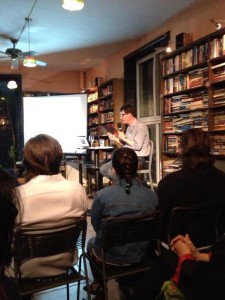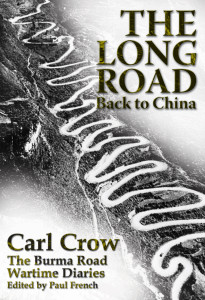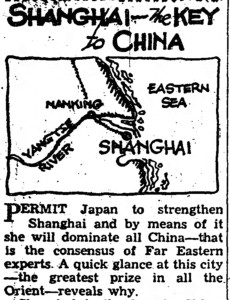Posted: September 25th, 2015 | No Comments »
Amazing to think the Beijing Bookworm has been ten years up those steep, steep steps of Nan Sanlitun! And so a brief trip down memory lane….
In those ten years I got to be on quite a few panels as well as moderating a host of great writers including Louise Welsh on Naming the Bones, Carol Birch on Jamrach’s Menagerie, Chris Womersley on Bereft, Qiu Xiaolong on Inspector Chen, Guy Delisle on Pyongyang, Michel Faber on The Crimson Petal and the White, Barbara Demick on North Korea, Catherine Sampson on Robin Ballantyne, Ridley Pearson on writing multiple bestsellers, Jonathan Fenby on warlord China and Yrsa Sigurðardóttir on Icelandic crime among others….
Plus, over the years, the Bookworm invited me to talk about foreign journalists in China, Carl Crow, the old Peking Badlands, Midnight in Peking and the Pamela Werner murder (which was originally a short story in the Bookworm’s own 2008 publication Beijing: Portrait of a City) and even Andre Malraux’s Man’s Fate one year. Penguin China kindly launched Midnight in Peking on the roof one hot August night and, after I decided to adapt Lao She’s short story Ding into a one-man monologue, we transformed the stage area into a Qingdao beach for a night!!
 Chatting with Carol Birch about her novel Jamrach’s Menagerie in 2012
Chatting with Carol Birch about her novel Jamrach’s Menagerie in 2012
 Talking murder, mayhem, opium and all round Peking Badlands badness…
Talking murder, mayhem, opium and all round Peking Badlands badness…
 With Qiu Xialong and Cathy Sampson talking criminal minds in 2009
With Qiu Xialong and Cathy Sampson talking criminal minds in 2009
 Up on the roof launching a book one hot August night in 2012
Up on the roof launching a book one hot August night in 2012
 You have to admit local actor Wang Xuankun was up for it to play Lao She’s Ding…on his own, with my script, in his trunks!!
You have to admit local actor Wang Xuankun was up for it to play Lao She’s Ding…on his own, with my script, in his trunks!!
 Clearly one of the more bizarre performances to graze the stage of the Bookworm in the last decade!!
Clearly one of the more bizarre performances to graze the stage of the Bookworm in the last decade!!
Posted: September 24th, 2015 | No Comments »
The rather horrible parade in Beijing the other week reminded me of Carl Crow’s wartime diaries (still available by the way here in the UK and here in the USA) …..And so an extract below that encapsulates more the reality of the war in Chungking, the raids and the daily life of the wartime capital that all got rather missed in the recent nationalism exercises in Tiananmen…..

Chungking, Wednesday, June 7th 1939.
I was too tired to stay up even for an air raid and soon went to sleep, but I was awoken frequently. I think it must have been too many cigarettes rather than worry over the raid. The house boy told me this morning that the planes passed close, “but have go other place.†The Chinese tell me it takes three and a half hours for the bombers to fly from Hankow to Chungking. They have a gas supply for 12 hours so that on the round trip they have a leeway of five hours in which to lay their exploding eggs, escape the pursuit planes and return. It’s very foggy this morning but the sun is breaking through so it may be clear this afternoon. I am full of aches, which I suppose is on account of my cold. More gossip flows in – Mrs. Wang told me that General Feng speaks with a salty humor that can’t be translated; American born Geraldine Skinner Wong has married a Chinese; our military spokesman today will be General Chang Jo-ping; a useful man from the Ministry of Economics is Dr. Lin Chi-yin; the cotton mill we visited the other day is called Tu Feng.
There is much talk of the financial collapse of both China and Japan. Certainly if the war continues it is only a question of which one will collapse first. But if the current quotations of the two currencies are any indication, then China is standing the strain better than Japan. The yen has been constantly slipping and is now worth only about 90% of the Chinese dollar. At 10 o’clock I called on the Secretary of the Women’s Committee of the New Life Movement. It was not a very satisfactory meeting and she displayed the usual indifference to figures and no one would even guess how many orphans are being cared for. This organization has a quota of 20,000, which it will soon reach. It is probably the charitable thing to say that they are all so busy that they haven’t had time to co-ordinate their reports. When I told her about visiting an orphanage she immediately asked whether or not they had been told that we were coming?
Chungking is a city of hills laid out with no regard for anything but pedestrian traffic. The skyline was so overcast at 4 o’clock that it looked like dusk and I felt sure that we were free from air raids for another day. Then at 5:45 the whistle blew. Holly Tong had been insistent that at the next raid I go to the Foreign Minister’s dugout so I asked where it was, thinking that if it were in the neighborhood I might walk around to it. They all insisted that it was too far to walk and before I knew what they were doing they had telephoned the Minister’s house and a car was on its way.
I walked down the street to meet it. As on the occasion of the other raid there was no apparent confusion. Everyone hurried but everyone knew where he was going. I passed the entrance to the public dugouts and they did not appear crowded. At the Minister’s house servants were covering the parked cars with cloth and matting. Some little girl next door was doing finger exercises on the piano and having some difficulty doing them. A boy brought me a tin of cigarettes and a cup of tea. Mr. and Mrs. Wu arrived. She looked even prettier than she had last Sunday. She went into the dugout with some other Chinese ladies while Mr. Wu and I stood outside to watch. He told me stories about Hitler and Mussolini. A half dozen other Chinese officials came in, including the Chinese Minister of Communications whom I had last seen on the Burma Road out of Chifon.
Chinese pursuit planes could be heard overhead and finally we saw three, six and finally 18. I couldn’t be sure because of the clouds. It has now been almost an hour since the alarm was given. Someone said that the first lot of Japanese planes had turned back but that a second lot was on the way. With all these pursuit planes in the air it appeared that there might be some thrilling fights and I had about made my mind up to stay outside and see the fun when we all got a thrill that was not on the program. A plane zoomed down past us and I wondered why anyone would be stunting in a power dive at a time like this. I saw the plane disappear over the edge of a hill and then it didn’t appear again. It looked like something was wrong. Then an American Governess said, “Is that a balloon?†It was just a speck but after a time we saw it was a parachute and could finally distinguish the man hanging from the ropes. It didn’t seem to me to be coming from the direction of the last plane and then I remembered seeing another plane that had apparently left the squadron on an independent flight of its own. So two Chinese planes may have been lost. Just then the all-clear signal was sounded. Apparently the show of force had frightened the Japanese away and the loss of two planes may have been a cheap price to pay for it. I walked back to the Guest House in less than ten minutes. The raid had lasted until 7 o’clock.
Posted: September 24th, 2015 | No Comments »
I’d never seen a Medaille Or de la Municipalite Francaise, the highest award from the French Concession Government. The obverse consists of the coat of arms or seal of the French Concession ringed with a banner reading “Concession Francaise de Changhai” There are tiny design credits of “L Mayol” to the left of the badge and “Paris Art” to the right of the badge. The reverse reads “Merite Civique”. There is also a punch mark on the rim between “concession” and “francaise” which reads 18K, an assay mark as to the gold content.
I’m not sure how many were given out by one was given to Colonel A.F. Marcaire, the long-serving Commander of French Armed Forces in Shanghai. His final campaign was to attempt to suppress Green Gang casinos in Shanghai. In 1932 he, along with some other French Concession dignitaries, was invited to Du Yuesheng’s (Big Eared Du, boss of the Green Gang) Rue Wagner mansion for dinner. Five attended – four, including Marcaire, died of poisoning, one managed to survive and left immediately for France while the host was fine and walked away from the table in perfect health!!

Posted: September 23rd, 2015 | No Comments »
‘Permit Japan to strengthen Shanghai and by means of it she will dominate all of China’ – this was, according to the American media in 1938, the consensus opinion of Far Eastern experts….
Posted: September 22nd, 2015 | No Comments »
As Xi visits DC – perhaps a good time to recall previous US engagements with China….Gregory Moore’s Defining and Defending the Open Door Policy….
 There has been little examination of the China policy of the Theodore Roosevelt administration. Works dealing with the topic fall either into brief discussions in biographies of Roosevelt, general surveys of Sino-American relations, or studies of special topics, such as the Chinese exclusion issue, which encompass a portion of the Roosevelt years. Moreover, the subject has been overshadowed somewhat by studies of problems between Japan and the United States in this era. The goal of this study is to offer a more complete examination of the American relationship with China during Roosevelt’s presidency. The focus will be on the discussion of major issues and concerns in the relationship of the two nations from the time Roosevelt took office until he left, something that this book does for the first time. Greater emphasis needs to be placed on creating a more complete picture of Teddy Roosevelt and China relations, especially in regard to his and his advisers’ perceptual framework of that region and its impact upon the making of China policy. The goal of this study is to begin that process. Special attention is paid to the question of how Roosevelt and the members of his administration viewed China, as it is believed that their viewpoints, which were prejudicial, were very instrumental in how they chose to deal with China and the question of the Open Door. The emphasis on the role of stereotyping gives the book a particularly unique point of view. Readers will be made aware of the difficulties of making foreign policy under challenging conditions, but also of how the attitudes and perceptions of policymakers can shape the direction that those policies can take. A critical argument of the book is that a stereotyped perception of China and its people inhibited American policy responses toward the Chinese state in Roosevelt’s Administration. While Roosevelt’s attitudes regarding white supremacy have been discussed elsewhere, a fuller consideration of how his views affected the making of foreign policy, particularly China policy, is needed, especially now that Sino-American relations today are of great concern.
There has been little examination of the China policy of the Theodore Roosevelt administration. Works dealing with the topic fall either into brief discussions in biographies of Roosevelt, general surveys of Sino-American relations, or studies of special topics, such as the Chinese exclusion issue, which encompass a portion of the Roosevelt years. Moreover, the subject has been overshadowed somewhat by studies of problems between Japan and the United States in this era. The goal of this study is to offer a more complete examination of the American relationship with China during Roosevelt’s presidency. The focus will be on the discussion of major issues and concerns in the relationship of the two nations from the time Roosevelt took office until he left, something that this book does for the first time. Greater emphasis needs to be placed on creating a more complete picture of Teddy Roosevelt and China relations, especially in regard to his and his advisers’ perceptual framework of that region and its impact upon the making of China policy. The goal of this study is to begin that process. Special attention is paid to the question of how Roosevelt and the members of his administration viewed China, as it is believed that their viewpoints, which were prejudicial, were very instrumental in how they chose to deal with China and the question of the Open Door. The emphasis on the role of stereotyping gives the book a particularly unique point of view. Readers will be made aware of the difficulties of making foreign policy under challenging conditions, but also of how the attitudes and perceptions of policymakers can shape the direction that those policies can take. A critical argument of the book is that a stereotyped perception of China and its people inhibited American policy responses toward the Chinese state in Roosevelt’s Administration. While Roosevelt’s attitudes regarding white supremacy have been discussed elsewhere, a fuller consideration of how his views affected the making of foreign policy, particularly China policy, is needed, especially now that Sino-American relations today are of great concern.
Posted: September 22nd, 2015 | No Comments »
If you’re in Hong Kong then this is probably worth a look, and maybe a chance to get rid of some annoying cash hanging about….
The Mapping of Asia
A collection of fine antique maps from 16th to 20th century
including a group of city plans

Sebastian Munster – Asia c.1540
The exhibition continues until 17th October 2015
Wattis Fine Art Gallery
20 Hollywood Road, 2/F, Central, Hong Kong
www.wattis.com.hk
Gallery open: Monday – Saturday 11am – 6pm
Posted: September 21st, 2015 | 1 Comment »
A lot has been written about Charlie Chan and the movies spawned from the books by Earl Derr Biggers. The movies played in the cinemas of the International Settlement of Shanghai and did not recieve any protests or censorship problems from the Nationalist government, as a number of movies deemed anti-Chinese did. In general in Shanghai Chan was seen as a positive character. When Warner Oland, the Swedish actor who played Chan in the majority of the Hollywood adaptations, visited China there was great interest in his visit, despite the issue of Yellowface.
America it seems was also interested in the fact that there were a series of Charlie Chan movies made in Shanghai starring Chinese actors (see advert below) – in these films (made initially in Shanghai and then, during the 1940s, Hong Kong) the detective has a daughter assisting him rather than a son. the actor Xu Xinyuan played Chan.
Anyway, here, from the American papers in 1937, is a cartoon of Xin noting the oddity of a Chinese imitating a Swede imitating a Chinese!!


Posted: September 20th, 2015 | No Comments »
RASÂ LECTUREÂ Â
Tuesday 22 September 2015
7:00 PM for 7:15 PM start
Radisson Blu Plaza Xingguo Hotel, Tavern Bar
78 XingGuo Road, Shanghai
Doug Clark on
GUNBOAT JUSTICE
How British and American judges and lawyers changed the history of China and JapanÂ
Foreign gunboats forced China, Japan and Korea to open to the outside world in the mid-19th century under treaties which required all three countries to exempt foreign nationals from local laws. This led to the establishment of British and American court systems which operated in China for over 100 years and in Japan for almost half a century. This system of Extraterritoriality has had a huge impact on how China and Japan view the world and impacts to this day on their mutual relationship, argues Douglas Clark in his new book, Gunboat Justice.
Gunboat Justice, published in three volumes by Earnshaw Books, is a full history of the era of extraterritoriality and the British and American courts that administered Western justice over their nationals in the Far East. Gunboats were often called in to quell local opposition to the courts’ authority. This book presents a fascinating cast of characters both on and before the bench and the many challenging issues the courts faced including war, riots, rebellion, corruption, murder, infidelity, and even a failed hanging in a British jail in Shanghai.
The book contains with over 300 contemporaneous cartoons, illustrations and photos of the judges, lawyers, court cases and historical events that affected the courts.
Praise for Gunboat Justice
“A riveting work. The original research has obviously been extensive and the style is easy, disguising the erudition behind it.”
-Rt. Hon. Sir Robin Jacob, Former Lord Justice of Appeal, Professor, University College of London
“A vital read. Here we find a century of foreign judges, lawyers and consuls attempting to control a city that attracted a legion of adventurers, criminals and sharks like no other in history. Gunboat Justice reveals the intersection of Shanghai’s formal administration and its dark underbelly. The most important book on Shanghai’s history for several decades.”
-Paul French, author of Midnight in Peking, winner of the Edgar Allan Poe award for best Fact Crime writing
“For the first time, we now have a comprehensive, well-informed and humane account of the people and procedures in the British and American courts of East Asia. Doug Clark’s book brings that world to life, and restores it to its place in our histories of the era of the ‘unequal treaties’.”Â
-Robert Bickers, author of Empire Made Me, and The Scramble for China 1832-1914
“A fascinating account of an extraordinary historical period with a wealth of intriguing characters – and a serious matter at its core.”Â
-Jonathan Fenby, Author of the Penguin History of Modern China
A pathbreaking study of an important but long neglected topic, this book is a fascinating read and invaluable resource for anyone with an interest in law, empire and history in modern East Asia.
 -Dani Botsman, Professor of History, Yale University, author of Punishment and Power in the Making of Modern Japan
Talk Cost: RMB 70.00 (RAS members) and RMB 100.00 (non-members). Includes glass of wine or soft drink. Those unable to make the donation but wishing to attend may contact us for exemption.
Membership applications and membership renewals will be available at this event. Those unable to make the donation but wishing to attend may contact us for exemption.
RAS Monographs: Series 1 & 2 will be available for sale at this event. RMB 100 each (cash sale only).
To RSVP:Â Please “Reply” to this email or write to
RAS Bookings at: bookings@royalasiaticsociety.org.cn
 Chatting with Carol Birch about her novel Jamrach’s Menagerie in 2012
Chatting with Carol Birch about her novel Jamrach’s Menagerie in 2012 Talking murder, mayhem, opium and all round Peking Badlands badness…
Talking murder, mayhem, opium and all round Peking Badlands badness… With Qiu Xialong and Cathy Sampson talking criminal minds in 2009
With Qiu Xialong and Cathy Sampson talking criminal minds in 2009 Up on the roof launching a book one hot August night in 2012
Up on the roof launching a book one hot August night in 2012 You have to admit local actor Wang Xuankun was up for it to play Lao She’s Ding…on his own, with my script, in his trunks!!
You have to admit local actor Wang Xuankun was up for it to play Lao She’s Ding…on his own, with my script, in his trunks!! Clearly one of the more bizarre performances to graze the stage of the Bookworm in the last decade!!
Clearly one of the more bizarre performances to graze the stage of the Bookworm in the last decade!!






